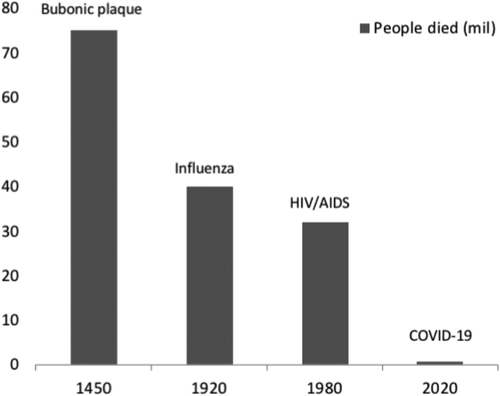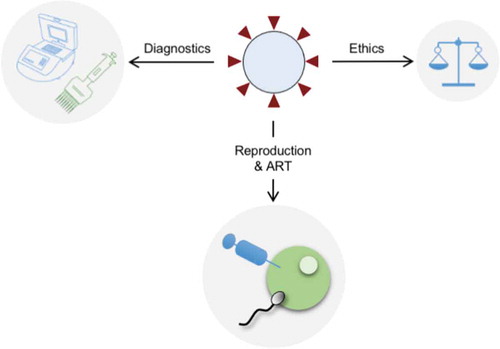Figures & data
Figure 1. Schematic presentation of the most world pandemics during history. The COVID-19 pandemic has (at August 2020) already caused the death of 0,65 million people, although it is impressive that this pandemic is at the beginning of its impact (only six months ago)

Figure 2. Infection of testicular cells by SARS-CoV-2. Different entry mechanisms and effects depending on ACE2 and TMPRSS2 are given at the top. A schematic shows interstitial Leydig cells, Sertoli cells and spermatogonial stem cells as indicated (SSC). Symbols in blue and green represent ACE2 and TMPRSS2, respectively. The image was created with BioRender licensed to CA Easley

Figure 3. scRNA-Seq expression data in testis for ACE2 and TMPRSS2. (A) A color-coded scatter plot identifies testicular cells types as shown in the legend. Regions showing clusters of macrophages (MP), Sertoli cells (SE), Leydig and peritubular cells (LE&PT), spermatogonia (SG), spermatocytes (SC) and spermatids (ST) are indicated. (B,C) Expression data are shown for genes as indicated at the top. The figure was created by M. Primig using the Reproductive Genomics Viewer’s scatter plot function (https://rgv.genouest.org; Darde et al., Bioinformatics Citation2019)

Table 1. Main gender-genetic differences and possible effects caused by potential SARS-CoV-2 infection on male and female gonadal cell types that express the ACE2 receptor
Figure 4. The impact of SARS-CoV-2. An overview of the current impact of COVID-19. As the viral curve is not flattening but continues to increase, COVID-19 raised a number of issues including the impact on reproductive research. Various diagnostic tests have been developed with NGS and SMS having the more diagnostic reliability in comparison to other molecular and antibody tests. Reproductive organs have been also affected by COVID-19, especially testis and ovaries raising the possibility that this virus may exert negative effects on reproduction and assisted reproduction. Nonetheless, COVID-19 brought to us bioethical issues as well, placing this pandemic, caused by this virus, as one of the biggest in the modern history

